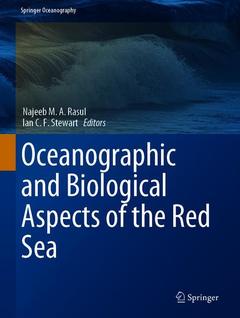Description
Oceanographic and Biological Aspects of the Red Sea, 1st ed. 2019
Springer Oceanography Series
Coordinators: Rasul Najeeb M.A., Stewart Ian C.F.
Language: English
Subjects for Oceanographic and Biological Aspects of the Red Sea:
Publication date: 01-2019
550 p. · 21x27.9 cm · Hardback
550 p. · 21x27.9 cm · Hardback
Description
/li>Contents
/li>Biography
/li>Comment
/li>
This book includes invited contributions presenting the latest research on the oceanography and environment of the Red Sea. In addition to covering topics relevant to research in the region and providing insights into marine science for non-experts, it is also of interest to those involved in the management of coastal zones and encourages further research on the Red Sea
Introduction to oceanographic and biological aspects of the Red Sea.- The tides of the Red Sea.- Physical and chemical properties of seawater in the Gulf of Aqaba and Red Sea.- Sources of organic tracers in atmospheric dust, surface seawater particulate matter and sediment of the Red Sea.- Nitrogen, phosphorus and organic carbon in the Saudi Arabian Red Sea coastal waters: Behaviour and human impact.- Automatic detection of coral reef induced turbulent boundary flow in the Red Sea from Flock-1 satellite data.- Red Sea coastal lagoons: Their dynamics and future challenges.- Distribution and sources of hydrocarbon compounds in sediments from Obhur Lagoon: Red Sea coast of Saudi Arabia.- Metal contamination assessment in the sediments of the Red Sea coast of Saudi Arabia.- Calcite and aragonite saturation levels of the Red Sea coastal waters of Yemen during early winter and expected pH decrease (acidification) effects.- Geochemistry and life at the interfaces of brine-filled deeps in theRed Sea.- Desalination of Red Sea and Gulf of Aden seawater to mitigate the fresh water crisis in the Yemen Republic.- Red Sea research: A personal perspective.- Endemic Fishes of the Red Sea.- Red Sea sharks - biology, fisheries and conservation.- Review of cetaceans in the Red Sea.- Where dolphins sleep: Resting areas in the Red Sea.- Status of Red Sea Dugongs.- Spatial patterns of standing stock and diversity of macrobenthic communities in the Red Sea.- Seagrass distribution, composition and abundance along the Saudi Arabian coast of Red Sea.- Current knowledge of coral diseases present within the Red Sea.- Physicochemical dynamics, microbial community patterns, and reef growth in coral reefs of the central Red Sea.- Meiofauna of the Red Sea Mangroves with emphasis on their response to habitat degradation: Sudan’s mangroves as a case study.- Morphology and anatomy of the pearl oyster, Pinctada margaritifera in the Red Sea: A case study from Dungonab Bay, Sudan.- Copepoda - their status and ecology in the Red Sea.- Zooplankton of the Red Sea.- Phytoplankton and primary production in the Red Sea.- The role of citizen science in monitoring megafauna of the Red Sea.
Dr. Najeeb M.A. Rasul holds a Master’s degree in Marine Geology, and has a Ph.D. in Geological Oceanography from the University of Wales, UK. He is presently a Technical Advisor at the Saudi Geological Survey (SGS) in Jeddah. For the past 15 years he has been associated with several organizations and has held key research positions at Geological and Geophysical Research Systems in Canada, the Challenger Division for Seafloor Processes at the National Oceanography Centre, Southampton, UK., Environment Canada in Burlington, Canada, and the Center for Marine Geology at the SGS, where he was the Head of the Center from 2003 to 2010. He has conducted research cruises with European Union Research centres, including the Institute of Marine Sciences (ISMAR), Italy and the IOC-UNESCO (TTR programme) and has been a EUROMARGINS and Saudi Scientific Coordinator. He has been involved in several research projects and cruises as chief scientist, and scientific investigator in the Pacific, Indianand Atlantic Oceans, including the Mid-Atlantic Ridge, Strait of Gibraltar, Gulf of Cadiz, Mediterranean Sea, Tyrrhenian Sea, Alboran Sea, Henderson Lake, Lake Erie, Arabian Gulf, Strait of Hormuz, Arabian Sea, and currently the Red Sea for the last 15 years. His research interests have concentrated on the fields of both shallow and deep water sedimentary processes, depositional mechanisms and environmental aspects. These include research on modern underwater sedimentary features and processes involved in their formation, deep sea turbidite systems, sediment dispersal and pathways, sediment plumes, fluxes and deposition, contaminants and chemical pathways for pollution and their environmental impact in both time and space, as well as marine mineral resources. He has also worked on the formation and exploration of oil and gas in deltas and offshore regions.
Dr. Ian C.F. Stewart received a Ph.D. in seismology from the University of Adelaide, South Australia. Fro
Provides up-to-date research results from the Red Sea Focuses on oceanography and environment of the Red Sea Educates public on various aspects of the marine sciences Provides information for policy makers in coastal zone management
© 2024 LAVOISIER S.A.S.




